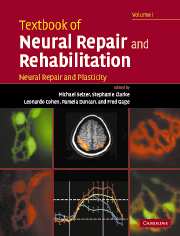Book contents
- Frontmatter
- Contents
- Contents (contents of Volume II)
- Preface
- Contributors (contributors of Volume I)
- Contributors (contributors of Volume II)
- Neural repair and rehabilitation: an introduction
- Section A Neural plasticity
- Section A1 Cellular and molecular mechanisms of neural plasticity
- Section A2 Functional plasticity in CNS system
- 6 Plasticity of mature and developing somatosensory systems
- 7 Activity-dependent plasticity in the intact spinal cord
- 8 Plasticity of cerebral motor functions: implications for repair and rehabilitation
- 9 Plasticity in visual connections: retinal ganglion cell axonal development and regeneration
- 10 Plasticity in auditory functions
- 11 Cross-modal plasticity in sensory systems
- 12 Attentional modulation of cortical plasticity
- Section A3 Plasticity after injury to the CNS
- Section B1 Neural repair
- Section B2 Determinants of regeneration in the injured nervous system
- Section B3 Promotion of regeneration in the injured nervous system
- Section B4 Translational research: application to human neural injury
- Index
6 - Plasticity of mature and developing somatosensory systems
from Section A2 - Functional plasticity in CNS system
Published online by Cambridge University Press: 05 March 2012
- Frontmatter
- Contents
- Contents (contents of Volume II)
- Preface
- Contributors (contributors of Volume I)
- Contributors (contributors of Volume II)
- Neural repair and rehabilitation: an introduction
- Section A Neural plasticity
- Section A1 Cellular and molecular mechanisms of neural plasticity
- Section A2 Functional plasticity in CNS system
- 6 Plasticity of mature and developing somatosensory systems
- 7 Activity-dependent plasticity in the intact spinal cord
- 8 Plasticity of cerebral motor functions: implications for repair and rehabilitation
- 9 Plasticity in visual connections: retinal ganglion cell axonal development and regeneration
- 10 Plasticity in auditory functions
- 11 Cross-modal plasticity in sensory systems
- 12 Attentional modulation of cortical plasticity
- Section A3 Plasticity after injury to the CNS
- Section B1 Neural repair
- Section B2 Determinants of regeneration in the injured nervous system
- Section B3 Promotion of regeneration in the injured nervous system
- Section B4 Translational research: application to human neural injury
- Index
Summary
Introduction
The somatosensory system of humans and other primates includes spinal cord and brain stem circuits and nuclei, several thalamic nuclei, and an array of cortical areas that are complexly interconnected to form an impressive network of functionally distinct, interacting parts (Kaas, 2004). The early stages of processing can be summarized in a highly simplified schematic that emphasizes serial steps in the system (Fig. 6.1). Due to nerve and brain injuries, strokes and degeneration, any component of this system can be damaged and partially or fully inactivated. The question we address in this review is what happens to the rest of the system when part of the system is damaged. The answer, of course, is that the system adjusts to the damage, and reorganizes. Components of this reorganization can be adaptive, and help compensate for the loss, but other components can be disruptive and lead to misperceptions, misguided motor control, and sometimes “thalamic” pain (e.g. Doetsch, 1998; Ramachandran and Hirstein, 1998; see Volume II, Chapter 15). Here we review what happens when damage occurs at each of four levels of the system: (a) the receptor or primary afferent level, (b) the level of the brain stem relay to the dorsal column-trigeminal complex, (c) the thalamic ventroposterior nucleus, and (d) primary somatosensory cortex. The effects of lesions of higher-order areas (e) have not been adequately studied yet. However, the consequence of damage not only depends on the level of the injury, but also on the extent and completeness of the injury.
Keywords
- Type
- Chapter
- Information
- Textbook of Neural Repair and Rehabilitation , pp. 97 - 108Publisher: Cambridge University PressPrint publication year: 2006



